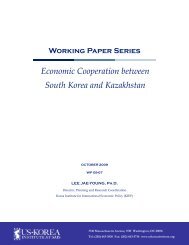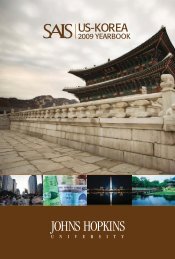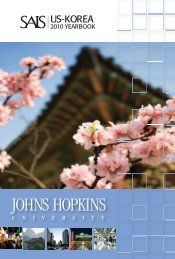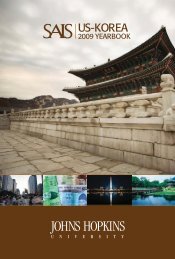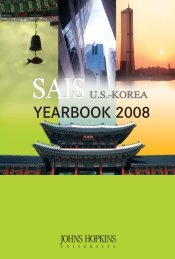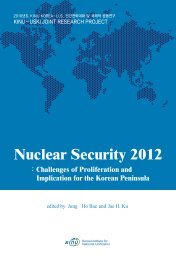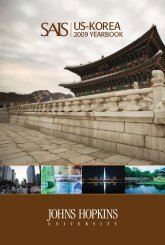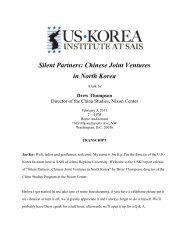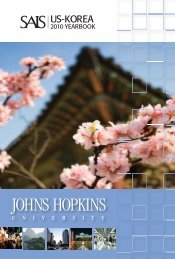Civil Society and the State in South Korea, by Michael Richardson
Civil Society and the State in South Korea, by Michael Richardson
Civil Society and the State in South Korea, by Michael Richardson
Create successful ePaper yourself
Turn your PDF publications into a flip-book with our unique Google optimized e-Paper software.
SAIS U.S.-KOREA YEARBOOK<br />
CIVIL SOCIETY AND THE STATE IN SOUTH KOREA<br />
someth<strong>in</strong>g to be desired. For <strong>the</strong> purposes of this paper, <strong>the</strong> London School of<br />
Economics <strong>Civil</strong> <strong>Society</strong> Centre’s work<strong>in</strong>g def<strong>in</strong>ition will suffice:<br />
<strong>Civil</strong> society refers to <strong>the</strong> arena of uncoerced collective action around<br />
shared <strong>in</strong>terests, purposes <strong>and</strong> values. In <strong>the</strong>ory, its <strong>in</strong>stitutional<br />
forms are dist<strong>in</strong>ct from those of <strong>the</strong> state, family <strong>and</strong> market, though<br />
<strong>in</strong> practice, <strong>the</strong> boundaries between state, civil society, family <strong>and</strong><br />
market are often complex, blurred <strong>and</strong> negotiated. <strong>Civil</strong> society<br />
commonly embraces a diversity of spaces, actors <strong>and</strong> <strong>in</strong>stitutional<br />
forms, vary<strong>in</strong>g <strong>in</strong> <strong>the</strong>ir degree of formality, autonomy <strong>and</strong> power.<br />
<strong>Civil</strong> societies are often populated <strong>by</strong> organisations such as registered<br />
charities, development non-governmental organisations, community<br />
groups, women’s organisations, faith-based organisations, professional<br />
associations, trade unions, self-help groups, social movements, bus<strong>in</strong>ess<br />
associations, coalitions <strong>and</strong> advocacy groups.<br />
The importance of civil society lies <strong>in</strong> its ability to provide a public space for <strong>the</strong><br />
<strong>in</strong>teraction of diverse societal values <strong>and</strong> <strong>in</strong>terests. As will be seen <strong>in</strong> <strong>the</strong> sections<br />
that follow, <strong>Korea</strong>n CSOs have played an active role <strong>in</strong> <strong>the</strong> past year <strong>in</strong> <strong>the</strong> public<br />
debate on a range of issues.<br />
II. HISTORY AND BACKGROUND<br />
In many ways, <strong>the</strong> growth of civil society <strong>in</strong> <strong>South</strong> <strong>Korea</strong> mirrors <strong>the</strong> growth<br />
of <strong>the</strong> nation’s economy. In <strong>the</strong> early 1960s, <strong>South</strong> <strong>Korea</strong>’s per capita GDP<br />
was lower than that of <strong>the</strong> Belgian Congo. Still recover<strong>in</strong>g from <strong>the</strong> ravages<br />
of <strong>in</strong>ternec<strong>in</strong>e war, <strong>Korea</strong> had not urbanized, <strong>and</strong> prospects for development<br />
looked bleak. Then <strong>the</strong>re followed, seem<strong>in</strong>gly out of nowhere, three decades of<br />
fantastic economic growth, dur<strong>in</strong>g which <strong>the</strong> country transformed itself from an<br />
impoverished backwater to an urban <strong>in</strong>dustrial powerhouse. By <strong>the</strong> end of <strong>the</strong><br />
20th century, <strong>South</strong> <strong>Korea</strong> boasted <strong>the</strong> 11th largest economy <strong>in</strong> <strong>the</strong> world.<br />
<strong>Civil</strong> society has emerged on <strong>the</strong> pen<strong>in</strong>sula with similar gusto. Though scholars<br />
debate <strong>the</strong> precise orig<strong>in</strong>s of civil society <strong>in</strong> <strong>Korea</strong> (some argue that it existed <strong>in</strong><br />
nascent form dur<strong>in</strong>g <strong>the</strong> Chosun dynasty, while o<strong>the</strong>rs see its birth com<strong>in</strong>g much<br />
later, dur<strong>in</strong>g <strong>the</strong> Japanese colonial era or <strong>the</strong> postwar period), <strong>the</strong>re is no doubt<br />
that organized civic groups have blossomed s<strong>in</strong>ce 1987. In that year, nationwide<br />
demonstrations forced <strong>the</strong> authoritarian Chun Doo-hwan regime to hold<br />
democratic elections <strong>and</strong> ushered <strong>in</strong> a new era of participatory politics <strong>in</strong> <strong>South</strong><br />
<strong>Korea</strong>.<br />
The years follow<strong>in</strong>g Chun’s capitulation saw an extraord<strong>in</strong>ary <strong>in</strong>crease <strong>in</strong> <strong>the</strong><br />
number <strong>and</strong> variety of <strong>South</strong> <strong>Korea</strong>’s civic groups <strong>and</strong> voluntary associations.<br />
As Hagen Koo notes <strong>in</strong> his study of <strong>Korea</strong>n civil society, <strong>the</strong>se groups “<strong>in</strong>cluded<br />
such organizations as <strong>the</strong> citizens’ coalition for economic justice, <strong>the</strong> league of<br />
anti-pollution movements, fem<strong>in</strong>ist groups, teachers’ associations for educational<br />
reform, journalists’ associations for press freedom, citizens’ watch groups for<br />
fair elections, citizen groups to fight political corruption or to fight regionalism,<br />
pressure groups for ensur<strong>in</strong>g responsive state agencies, <strong>and</strong> so forth.”<br />
A cursory glance at <strong>the</strong> civil society groups that sprouted <strong>in</strong> this period shows<br />
most of <strong>the</strong>m to be liberal, if not leftist. This should come as no surprise.<br />
Traditionally, such “liberal” <strong>in</strong>terests as press freedom, environmental protection,<br />
<strong>and</strong> women’s rights were precisely <strong>the</strong> <strong>in</strong>terests that had been ignored or<br />
suppressed dur<strong>in</strong>g <strong>South</strong> <strong>Korea</strong>’s authoritarian period. Liberalization of <strong>the</strong><br />
political sphere thus paved <strong>the</strong> way for <strong>the</strong> liberalization (<strong>and</strong>, <strong>in</strong> some sense,<br />
liberation) of civil society. The nature <strong>and</strong> composition of <strong>the</strong>se new civic<br />
organizations reflected a degree of dissatisfaction with <strong>the</strong> course of <strong>the</strong> country’s<br />
development. <strong>State</strong>-led economic growth had transformed <strong>South</strong> <strong>Korea</strong>, but it<br />
had also stymied <strong>the</strong> political <strong>and</strong> social aspirations of large segments of society.<br />
Civic groups <strong>in</strong> <strong>the</strong> 1990s sought to compensate for those decades of neglect.<br />
III. RECENT TRENDS: THE POLARIZATION OF CIVIL SOCIETY<br />
The growth of civil society cont<strong>in</strong>ued apace under <strong>the</strong> adm<strong>in</strong>istration of<br />
President Roh Moo-hyun. More than ei<strong>the</strong>r of his two democratically elected<br />
predecessors, he actively courted <strong>and</strong> supported a wide variety of civic groups.<br />
Hav<strong>in</strong>g won <strong>the</strong> 2002 election on a wave of youthful, progressive support, he<br />
proceeded to build a “participatory government” that both <strong>in</strong>creased f<strong>in</strong>ancial<br />
back<strong>in</strong>g for civic groups <strong>and</strong> encouraged direct civil society participation <strong>in</strong><br />
<strong>the</strong> policymak<strong>in</strong>g process. President Roh Moo-hyun also cont<strong>in</strong>ued former<br />
President Kim Dae-jung’s practice of <strong>in</strong>vit<strong>in</strong>g prom<strong>in</strong>ent civic group leaders<br />
to jo<strong>in</strong> his adm<strong>in</strong>istration. The consequences of this support for progressive<br />
civil society have varied. For one th<strong>in</strong>g, participation <strong>in</strong> <strong>and</strong> giv<strong>in</strong>g to voluntary<br />
organizations have <strong>in</strong>creased over <strong>the</strong> past five years. For ano<strong>the</strong>r, <strong>the</strong> onl<strong>in</strong>e<br />
“netizen” community has garnered considerable power as an <strong>in</strong>formal force for<br />
political <strong>and</strong> social change.<br />
At <strong>the</strong> same time, however, <strong>the</strong> close ties between government <strong>and</strong> civil society<br />
have provoked a conservative backlash. If <strong>the</strong> growth of progressive civic groups<br />
can be seen as a reaction to conservative, authoritarian rule, <strong>the</strong>n <strong>the</strong> growth of<br />
conservative civic groups can be seen as just <strong>the</strong> opposite: a reaction to liberal,<br />
progressive rule. The New Right NGOs <strong>and</strong> political religious groups that<br />
have recently appeared are representative of this trend. One such group, <strong>the</strong><br />
New Right Union, explicitly claims to comb<strong>in</strong>e <strong>the</strong> functions of a civil society<br />
organization <strong>and</strong> a political movement organization. Boast<strong>in</strong>g some 15,000<br />
166 167



